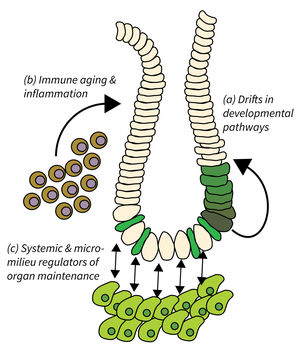Subarea 2: Regeneration and Homeostasis of Organs in Aging
The main goal of Subarea 2 is to identify cellular and molecular pathways used to ensure effective organ maintenance and repair, and to unravel the mechanisms of their deterioration during aging. While stem cells are important for organ homeostasis, this Subarea does not per se directly addresses stem cell aging but rather focusses on the following focus areas:
- Drifts in developmental pathways limiting organ maintenance in aging,
- Immune aging and inflammation, and
- Systemic and micro-milieu regulators of organ maintenance, regeneration, and disease development.
Research focus of Subarea 2
Organ maintenance is regulated by local and systemic factors, which are subject to aging-associated changes. Research of Subarea 2 focuses on the following research areas: a) Genetic and epigenetic modulation of developmental pathways has been shown to contribute to progressive aging and disease. It is critical to delineate mechanisms and consequences of aging-associated drifts to better understand organ maintenance during aging. b) Immunoaging and chronic inflammation elicits negative effects through reduced immune surveillance and aberrant organ repair and maintenance; all of which contributes to the evolution of organ pathologies and diseases during organismal aging. c) Furthermore, aging-associated alterations in systemic and extracellular factors derived from metabolic changes, microbiota alterations, chronic inflammation, senescent, or damaged cells might impinge on disease development and tumor initiation.
Publications
(since 2016)
2018
- TRPS1 shapes YAP/TEAD-dependent transcription in breast cancer cells.
Elster* D, Tollot* M, Schlegelmilch K, Ori A, Rosenwald A, Sahai E, von Eyss B
Nat Commun 2018, 9(1), 3115 * equal contribution - 2016 Children's Tumor Foundation conference on neurofibromatosis type 1, neurofibromatosis type 2, and schwannomatosis.
Fisher MJ, Belzberg AJ, de Blank P, De Raedt T, Elefteriou F, Ferner RE, Giovannini M, Harris GJ, Kalamarides M, Karajannis MA, Kim A, Lázaro C, Le LQ, Li W, Listernick R, Martin S, Morrison H, Pasmant E, Ratner N, Schorry E, Ullrich NJ, Viskochil D, Weiss B, Widemann BC, Zhu Y, Bakker A, Serra E
Am J Med Genet A 2018, 176(5), 1258-69 - Tuberous sclerosis complex is required for tumor maintenance in MYC-driven Burkitt's lymphoma.
Hartleben G, Müller C, Krämer A, Schimmel H, Zidek LM, Dornblut C, Winkler R, Eichwald S, Kortman G, Kosan C, Kluiver J, Petersen I, van den Berg A, Wang ZQ, Calkhoven CF
EMBO J 2018, 37(21), e98589 - Sepsis-associated encephalopathy.
Helbing DL, Böhm L, Witte OW
CMAJ 2018, 190(36), E1083 - Glucocorticoid receptor in stromal cells is essential for glucocorticoid-mediated suppression of inflammation in arthritis.
Koenen M, Culemann S, Vettorazzi S, Caratti G, Frappart L, Baum W, Krönke G, Baschant U, Tuckermann JP
Ann Rheum Dis 2018, 77(11), 1610-8 - RelB regulates Th17 differentiation in a cell-intrinsic manner.
Koliesnik IO, Andreas N, Romanov VS, Sreekantapuram S, Krljanac B, Haenold R, Weih F
Immunobiology 2018, 223(2), 191-9 - Role of thyroid hormone in ischemic brain injury.
Kramer F
Dissertation 2018, Jena, Germany - Deletion of Menin in craniofacial osteogenic cells in mice elicits development of mandibular ossifying fibroma.
Lee S, Liu P, Teinturier R, Jakob J, Tschaffon M, Tasdogan A, Wittig R, Hoeller S, Baumhoer D, Frappart L, Vettorazzi S, Bertolino P, Zhang C, Tuckermann J
Oncogene 2018, 37(5), 616-26 - Heat Shock Factor 1 Epigenetically Stimulates Glutaminase-1-Dependent mTOR Activation to Promote Colorectal Carcinogenesis.
Li J, Song P, Jiang T, Dai D, Wang H, Sun J, Zhu L, Xu W, Feng L, Shin VY, Morrison H, Wang X, Jin H
Mol Ther 2018, 26(7), 1828-39 - Thyroid Hormone Transporters MCT8 and OATP1C1 Control Skeletal Muscle Regeneration.
Mayerl S, Schmidt M, Doycheva D, Darras VM, Hüttner SS, Boelen A, Visser TJ, Kaether C, Heuer** H, von Maltzahn** J
Stem Cell Reports 2018, 10(6), 1959-74 ** co-corresponding authors









